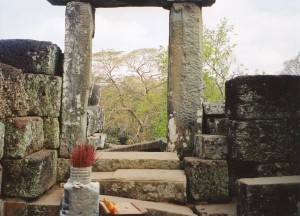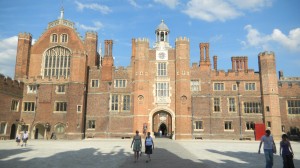The last post flew between many cultures at 6,000MPH, so we’ll balance it today with a view of the same Khmer temple from Planet Earth.
Yes, Phimeanakas was the royal chapel in the middle of the palace in Angkor, and the 11th century king Suryavarman I used its symmetry to order the state. But a colorful folk tale about it emerged.
In 1296-7, a Chinese businessman and envoy named Zhou Daguan lived in Angkor. He wrote of a legend about the Khmer king sleeping with a courtesan in the room on Phimeanakas’ summit every night.
She represented a naga princess who transformed into a beautiful woman (nagas are serpents who live under water, with powers to fertilize the land and bring wealth to people–Indians and Southeast Asians have held many beliefs about them). Some Khmers and Chinese residents believed that this ritual fertilized the kingdom. It was a meeting of the king’s solar power and earthly energies.
If so, it wasn’t a casual fling. The room at the top was very small, with only enough room for one bed–not much area for the frivolties that a lusty monarch like Henry VIII (one of his crash pads, Hampton Court, is pictured below) or Francois I would have enjoyed. And the stairs to the ground are steep enough to be dangerous to descend.
So the ceremony probably only occurred in people’s imaginations. But those imaginations had very deep roots. Khmers had long believed that their royal house was founded by a brahman from India who made love to the local naga princess. Ideas of snakes bestowing fertility on the land were common all over mainland Southeast Asia before Indian merchants came over around 1 CE and buddied with local rulers. So between the building of Phimeanakas and 1297, an ancient network of ideas might have gotten attached to Suryavarman’s stately monument.
It’s hard to imagine such a tale being associated with the Romanesque cathedrals in my recent posts. These buildings and Suryavarman’s monuments have strict symmetries that were supposed to represent an all-encompassing political and spiritual order. But Southeast Asian cultures are pluralistic–they have many belief systems side by side, and older beliefs about spirits and animated powers are still strong. They coexist with Hindu, Buddhist and Islamic faiths, and with modernity.
And this enormous variety of beliefs isn’t hemmed in by a single system of theology or philosophy. But its exuberant irreducibility is reflected in Angkor’s ornate temples, and in Angkor’s tropical environment (please see yesterday’s post). Its a different world, and you’ll never run out of varieties to savor. I can’t wait to go back to Cambodia in three months. Don’t know if I’ll find a naga princess though.



Comments on this entry are closed.